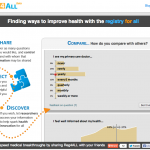 The past year has seen a growing number of organisations looking to tap into the wisdom of the crowds to improve medical diagnosis. Perhaps the most mainstream of these was Figure1. Whilst most diagnoses are provided by the doctors in the facility you’re being treated in, Figure1 wanted to open things up to doctors from anywhere. A photo would be taken of your condition, and doctors could easily turn to the crowd for a second opinion.
The past year has seen a growing number of organisations looking to tap into the wisdom of the crowds to improve medical diagnosis. Perhaps the most mainstream of these was Figure1. Whilst most diagnoses are provided by the doctors in the facility you’re being treated in, Figure1 wanted to open things up to doctors from anywhere. A photo would be taken of your condition, and doctors could easily turn to the crowd for a second opinion.
A slightly more ambitious project was CrowdMed. It’s a healthcare prediction market, with participants betting on the diagnosis of a condition, with their available currency fluctuating based upon their success. These bets form the basis of a prediction market, with the suggested diagnosis rising and falling in price, just like stocks on the stock exchange.
The site then uses algorithms to calculate the probability that each diagnosis is correct. Once the crowd have arrived at their consensus, the CrowdMed site shows patients the top three suggestions, which they are then free to explore with their doctor. If the diagnosis proves correct, the doctor is encouraged to feed the results back into the site, with the participants rewarded accordingly.
Another project along similar lines has recently launched. Developed by the Genetic Alliance and the Pharmaceutical Research and Manufacturers of America, the platform aims to gather patient input on various diseases and medications.
Snazzily titled, the Platform for Engaging Everyone Responsibly (PEER) will allow individuals to share their health information using a comprehensive dashboard. PEER engages with participants by asking them to complete a gamified survey that gives them real time information against other users on the site.
This information will then be used to improve the clinical trials process, both in terms of cost and efficiency. While the rest of the developed world recruits individuals for various endeavours through customized and engaging online tools, biomedical research still tries to enroll individuals as it has for decades: leaning on clinicians who have limited time, posting ads on buses and in subways, even newspapers.
The aim is to ensure that the right clinical trial is directed at the specific person that requires it, rather than relying on chance to match up the respective parties. What’s more, it also ensures that any data generated from the trials is shared with other researchers, thus removing the proprietary silos that often form around research efforts.
It’s certainly an interesting approach to improving the efficiency of a critical area of medical life. It should be interesting to see how it develops and the results that begin to emerge from it.
Thanks a lot for sharing this. What they’re doing is actually very smart. I honestly think it is the right way to do it, ensuring that the right clinical trial is directed at the specific person that requires it.